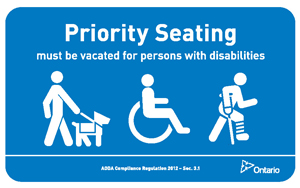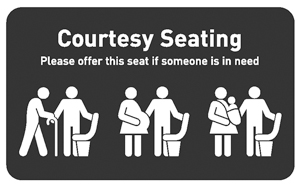To help keep the conventional bus on schedule, it is important that boarding, securing, and exiting the bus is completed as quickly as possible.
Boarding the Bus
- Riders must be four to five feet away from the front door of the bus, allowing for adequate clearance before entering the bus.
- Upon request, Transit Operators will provide assistance to secure passengers who travel in a wheelchair. Operators will not be lifting individuals. Persons needing additional assistance should travel with a support person.
- Priority and courtesy seating is available at the front of the bus for persons with reduced mobility, including seniors and those using a wheelchair or scooter. These seats are available on a first come first serve basis.
- Transit Operators will assist the safe and careful storage of mobility aids used by persons with disabilities.
Boarding the Bus with a wheelchair or scooter
- When boarding the conventional bus, keep back at least 1.5 m (5 feet) from the front doors so the ramp can be safely extended. Passengers using a wheelchair or scooter are required to board independently and position their mobility device inside the bus, or bring an attendant to assist them.
- The maximum size of a wheelchair or scooter, including all attachments, on a low-floor bus is 71 cm (28 inches) wide, by 122 cm (48 inches) long.
- With the wheelchair or scooter in a forward facing position, the securement system must be fastened. Transit Operators will assist with frame belts and a lap belt is provided if your wheelchair or scooter doesn't have one.
- Power to electric wheelchairs or scooters must be turned off, and wheelchair brakes must be applied.
Exiting the Bus
- When you are approaching your bus stop, press the yellow stop to signal the Transit Operator.
- Once the bus has come to a complete stop, please move to face the front of the bus and proceed to the safety line on the bus floor.
- Stay behind the safety line on the floor of the bus until the ramp has been completely lowered by the driver.
- Move onto the ramp facing forward and exit the bus.
Exiting the Bus with a wheelchair or scooter
- Customers travelling in a wheelchair or scooter will notice a yellow touch strip on the edge of the flip-seats. Pressing this strip will notify the Transit Operator that you wish to exit the bus at the next stop.
- The Transit Operator will assist with the removal of the securement system and where necessary deploy the ramp for exiting.



